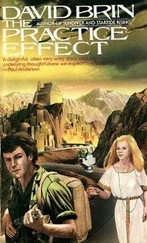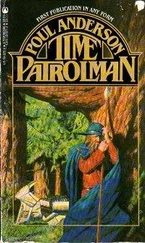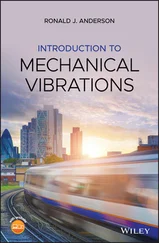Ronald J. Anderson - The Practice of Engineering Dynamics
Здесь есть возможность читать онлайн «Ronald J. Anderson - The Practice of Engineering Dynamics» — ознакомительный отрывок электронной книги совершенно бесплатно, а после прочтения отрывка купить полную версию. В некоторых случаях можно слушать аудио, скачать через торрент в формате fb2 и присутствует краткое содержание. Жанр: unrecognised, на английском языке. Описание произведения, (предисловие) а так же отзывы посетителей доступны на портале библиотеки ЛибКат.
- Название:The Practice of Engineering Dynamics
- Автор:
- Жанр:
- Год:неизвестен
- ISBN:нет данных
- Рейтинг книги:3 / 5. Голосов: 1
-
Избранное:Добавить в избранное
- Отзывы:
-
Ваша оценка:
The Practice of Engineering Dynamics: краткое содержание, описание и аннотация
Предлагаем к чтению аннотацию, описание, краткое содержание или предисловие (зависит от того, что написал сам автор книги «The Practice of Engineering Dynamics»). Если вы не нашли необходимую информацию о книге — напишите в комментариях, мы постараемся отыскать её.
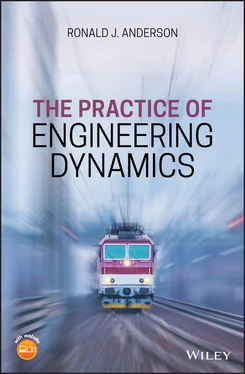
 with respect to
with respect to  is then,
is then,
 with respect to
with respect to  to be,
to be,
 is defined to be,
is defined to be,

 and the acceleration
and the acceleration  are relative to the fixed or inertial point
are relative to the fixed or inertial point  , they are in fact the absolute velocity and acceleration of point
, they are in fact the absolute velocity and acceleration of point  . We commonly write absolute velocities and accelerations without subscripts yielding,
. We commonly write absolute velocities and accelerations without subscripts yielding,

 is of fixed length
is of fixed length  and is free to rotate about a vertical axis through point
and is free to rotate about a vertical axis through point  with angular speed
with angular speed  . Arm
. Arm  has a variable length
has a variable length  and is free to rotate about an axis passing through points
and is free to rotate about an axis passing through points  and
and  with angular speed
with angular speed  . The end effector is located at point
. The end effector is located at point  . Of interest for the kinematic analysis are expressions for the absolute velocity and acceleration of the end effector.
. Of interest for the kinematic analysis are expressions for the absolute velocity and acceleration of the end effector.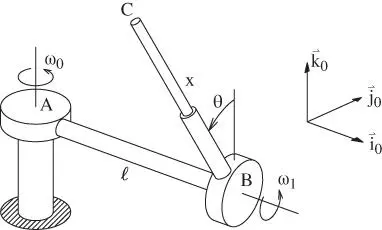
 ,
,  ,
,  ) fixed in the arm
) fixed in the arm  . This is a rotating coordinate system with angular velocity
. This is a rotating coordinate system with angular velocity  .
. is just as outlined in Section 1.2. The first step is to find a fixed point. In this system, point
is just as outlined in Section 1.2. The first step is to find a fixed point. In this system, point  serves the purpose as it has no velocity or acceleration.
serves the purpose as it has no velocity or acceleration. to
to  . This is the vector
. This is the vector  shown in Figure 1.6. Notice that it goes through space from
shown in Figure 1.6. Notice that it goes through space from  to
to  and its rate of change cannot be described directly using the motions of the physical components of the system.
and its rate of change cannot be described directly using the motions of the physical components of the system.
 to
to  (
(  ) and then add to it a vector that goes from
) and then add to it a vector that goes from  to
to  (
(  ). That is,
). That is,